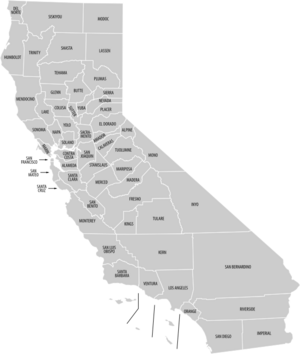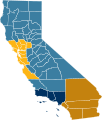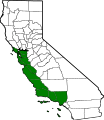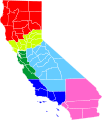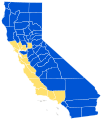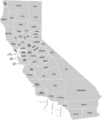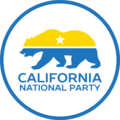Partition and secession in California facts for kids
California is the state with the most people in the United States. It's also the third largest state in size, after Alaska and Texas. Since California joined the United States in 1850, many people have suggested splitting it into several smaller states. There have been over 220 ideas to divide California, with at least 27 big proposals in its first 150 years. Sometimes, people also suggest that parts of Northern California should join larger regions in the American West, like the idea of Cascadia, which would be its own country.
Contents
How California Was Divided Before

California was actually split up even before it became a U.S. state. When Spain ruled, the area was called the Province of Las Californias. This huge area stretched almost 2,000 miles (3,200 km) from north to south. In 1804, it was divided into Alta California (Upper California) and Baja California (Lower California). The dividing line was between the Franciscan missions in the north and the Dominican missions in the south.
After the Mexican–American War (1846-1848), most of Alta California became part of the United States. The western part became the state of California we know today. Other parts of Alta California later became the states of Nevada, Utah, and parts of Arizona and Wyoming. The rest of Alta California, including modern-day Tijuana and Mexicali, stayed under Mexican rule as the Baja California Territory. This territory was later split into two Mexican states in 1931.
In 1888, under President Porfirio Díaz, Baja California became a federal territory called the North Territory of Baja California. In 1952, the northern part of this territory became the 29th state of Mexico, named Baja California. The southern part, which didn't have many people, remained a federal territory. In 1974, it became the 31st state of Mexico, called Baja California Sur.
History of Ideas to Split California
Before California Became a State
The land that is now California became part of the U.S. after America won the Mexican–American War in 1848. After the war, there was a big disagreement between states that allowed slavery (slave states) and states that did not (free states). The South wanted to extend the Missouri Compromise line, which would have allowed slavery in Southern California. The North did not want this.
Starting in late 1848, many people from different countries rushed into California because of the California Gold Rush. This caused the population to grow very quickly. People wanted a better government, so a special meeting was held in 1849 to write a constitution. At this meeting, everyone agreed to outlaw slavery. The southern part of California had never had much slavery and had many Hispanic people. The delegates asked for California to become a state with its current borders. As part of the Compromise of 1850, the Southern states in Congress reluctantly agreed that California would be a free state. California officially became the 31st state on September 9, 1850.
After California Became a State
Southern California tried three times in the 1850s to become its own state or territory, separate from Northern California.
- In 1855, the California State Assembly passed a plan to split the state into three parts. The southern counties, which today have about two-thirds of California's population, would become the State of Colorado. The northern counties, which today have less than a million people, would become the State of Shasta. The main reason for this idea was that California was too big. People felt it was too large for one government, and the state capital was too far away for people in Southern California. This bill did not pass in the California State Senate.
- In 1859, the state legislature and governor approved the Pico Act. This act would have split off the region south of the 36th parallel north to create the Territory of Colorado. The main reason given was the cultural and geographical differences between Northern and Southern California. Voters in the proposed new territory strongly approved the idea. However, the start of the American Civil War in 1860 stopped this plan from ever being voted on in Washington, D.C.
- In the late 1800s, there was talk of splitting the state in two at the Tehachapi Mountains. This was because it was hard to travel across the rugged mountains. The discussion ended when people realized they could build a highway over the mountains. This road later became part of Interstate 5.
20th Century Ideas
- Since the mid-1800s, people have suggested that the mountainous parts of northern California and southwestern Oregon should become a separate state. In 1941, some counties in this area even pretended to secede one day a week, calling themselves the State of Jefferson. This idea faded when America entered World War II. However, the idea has come back in recent years.
- On June 4, 1965, the California State Senate voted to divide California into two states, using the Tehachapi Mountains as the border. This plan would have separated the seven southern counties, which had most of the state's population, from the other 51 counties. The proposal passed in the Senate but did not get approved by the State Assembly.
- In 1992, State Assemblyman Stan Statham proposed a bill to let each county vote on splitting California into three new states: North, Central, and South California. This idea passed in the State Assembly but failed in the State Senate.
21st Century Ideas
-
2013: Tim Draper's Six Californias proposal. This map shows six suggested new states: Jefferson, North California, Silicon Valley, Central California, West California, and South California.
-
2018: Tim Draper's Cal 3 proposal. This map shows three suggested new states: Northern California, California, and Southern California.
- After the 2003 election to recall the governor, Tim Holt and Martin Hutchinson suggested splitting California into as many as four new states. They wanted to divide different areas like the Bay Area, North Coast, and Central Valley, as well as the historic Shasta/Jefferson region.
- In 2009, former State Assemblyman Bill Maze tried to split off thirteen coastal counties into a separate state called "Coastal California" or "Western California." These counties usually vote for the Democratic party. Maze believed that "conservatives don't have a voice" and that Los Angeles and San Francisco "control the state."
- In June 2011, Republican Riverside County Supervisor Jeff Stone suggested that 13 counties in Southern California should form a new state called South California. Officials in Sacramento thought this idea was ridiculous. Governor Jerry Brown's spokesperson said, "A secessionist movement? What is this, 1860? It's a supremely ridiculous waste of everybody's time."
- In September 2013, county leaders in Siskiyou County and Modoc County voted to join a plan to create a new "State of Jefferson." This group hopes to get many counties to agree, then ask the state legislature to allow the new state to form. By July 2014, several other counties, including Glenn, Yuba, and Tehama, also voted to support this idea.
- Six Californias: On December 19, 2013, investor Tim Draper proposed splitting California into six new states. He believed this would lead to better representation and government. His proposal got enough signatures to be considered for a vote, but it did not qualify for the November 2016 ballot.
- New California: On January 16, 2018, a group called New California, led by Paul Preston, published its own "Declaration of Independence." Preston said California was not good for businesses and had high taxes. His plan for New California would include most of the state's rural counties, leaving out the more populated areas around San Francisco, Sacramento, and Los Angeles.
- In April 2018, the Cal 3 group announced they had enough signatures to put a plan on the November 2018 ballot to split California into three separate states. This was approved by June 13, 2018. However, in July 2018, the California Supreme Court stopped the Cal 3 proposal from being on the ballot to review it further.
- In 2020, a group called "Move Oregon's Border For a Greater Idaho" suggested that most of Oregon and some of Northern California should break away and join Idaho. These areas usually vote for the Republican party, but their state governments are controlled by Democrats. Even if voters approve this idea, it would still need approval from the legislatures of all three states.
Joining Other States
Ecotopia
Writer Ernest Callenbach wrote a novel in 1975 called Ecotopia. In this book, he imagined Northern California, Oregon, and Washington leaving the United States to focus on living in an environmentally friendly way. He later changed his mind, saying that all places are now connected by issues like climate change.
Cascadia
Cascadia is an idea for a new country that would mostly include Washington, Oregon, Idaho, and British Columbia in Canada. However, plans for an independent Cascadia often include parts of northern California as well.
Californian Reunification
Some people have thought about reuniting California. This idea often includes modern-day California, Baja California, and Baja California Sur. These are the lands that were once part of the Province of Las Californias (1767-1804).
California Becoming Independent
Before America took over, California declared itself independent from Mexico in 1846 during the Bear Flag Revolt. This happened during the Mexican–American War. After California became part of the U.S., there weren't many independence movements until the election of Donald Trump in 2016.
Many groups now want California to become its own country. They often argue that California has the fifth-largest economy in the world. It is also home to major centers for entertainment (Hollywood) and technology (Silicon Valley).
California National Party
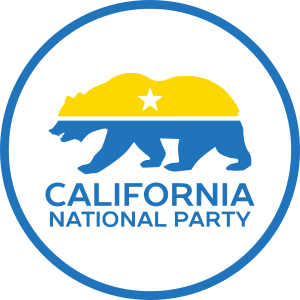
The California National Party (CNP) was started in 2015. It is a political party that wants California to become independent from the United States in a legal and peaceful way. The party's name and goals are partly inspired by the Scottish National Party, which is a party in Scotland that also wants independence.
California Freedom Coalition
The California Freedom Coalition is a political group that started in 2017. It works to give Californians more power in politics, the economy, and society. It supports ideas like universal healthcare for everyone in California and more money for education in California. It also supports the possibility of California becoming independent.
Yes California
After Donald Trump won the 2016 presidential election, a group called Yes California started a movement called "Calexit." This name was inspired by "Brexit," when the UK left the European Union. The group tried to get enough signatures to put a question about California leaving the U.S. on the 2018 ballot. In July 2018, their goals expanded to include creating an "autonomous Native American nation" in eastern California. They also decided to try to convince Republican states to support their plan instead of just focusing on a ballot vote. "Yes California" was founded by Louis J. Marinelli, who moved to Russia and had support from the Russian government.
Images for kids
-
The original Province of Las Californias within the Viceroyalty of New Spain (1768–1804)
-
2013: Tim Draper's Six Californias proposal
-
2018: Tim Draper's Cal 3 proposal
-
Logo of the California National Party


